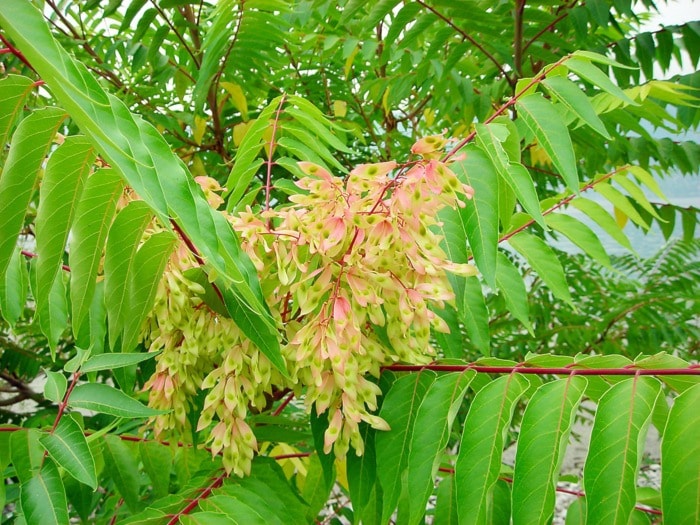Tree of heaven is one of the most aggressive and prominent invasive trees in the Okanagan-Similkameen.
This tree commonly grows in disturbed urban areas where it sprouts up just about anywhere – alleys, sidewalks, parking lots and streets. In rural areas, tree of heaven grows in fields, along roadsides, lakeshores and forest edges.
Because of its rapid growth, tree of heaven can easily displace and out-compete native vegetation, forming dense thickets. It also produces chemicals that can prevent the establishment of other plant species.
In residential areas, the root system of tree of heaven can cause damage to sewers and foundations.
Originally from China, tree of heaven (Ailanthus altissima) was first introduced into North America in the late 1700s.
It is known by several other names, most commonly are Ailanthus, Chinese sumac, stinking sumac. By 1840, tree of heaven became a common stock in eastern nurseries, valued for its ability to grow in poor soil with little care.
The second route the tree of heaven came to America’s shore was on the West Coast through Chinese miners.
During the days of the gold rush, many Chinese miners brought ailanthus seeds with them as they settled in the West Coast, probably because of its medicinal and cultural importance to them. Tree of heaven rapidly spread across the continent because of its ability to grow quickly under adverse conditions, although it is a shade intolerant species. It also produces poisonous “ailanthene” in bark and leaves that helps limit competition.
It thrives in disturbed locations and can pose a serious threat to natural areas recently opened to sunlight.
Tree of heaven can reach over 18 metres in height. The leaves are 0.3-0.9 m long, with each leaf comprised of 10 to 41 lance-shaped leaflets. The bark of this tree is extremely smooth and pale gray in color.
The greenish-yellow flowers appear in late spring and occur in large terminal clusters. Evident right now are the flat, twisted, winged fruits that each contains a single central seed. All parts of the tree, especially the leaves and flowers, have a nutty or burned nut odor.
Tree of heaven reproduces both by seeds and through vegetative sprouting.
One study reports that an individual tree can produce as many as 325,000 seeds per year. Established trees produce numerous suckers from the roots and resprout vigorously from cut stumps and root fragments.
If you are trying to control this tree on your property, here are a few tips. Seedlings can be hand-pulled when the soil is moist. Once the trees become firmly established, the most effective control method is the cut-stump herbicide treatment during late spring.
This method is both labour intensive and expensive, but can be highly effective. Bulldozing, mowing and brush cutting can also be effective, but only if all re-sprouts are continually cut and removed which will likely take many consecutive years of treatment. I strongly encourage anyone dealing with invasive trees to consult with a professional before attempting these control techniques. I would love to hear from anyone who has successfully battled these giant weed trees.
For further information on invasive plants contact the Invasive Plant Program Coordinator for the Okanagan-Similkameen, Lisa Scott at 250-404-0115 or e-mail her at sosips@shaw.ca
